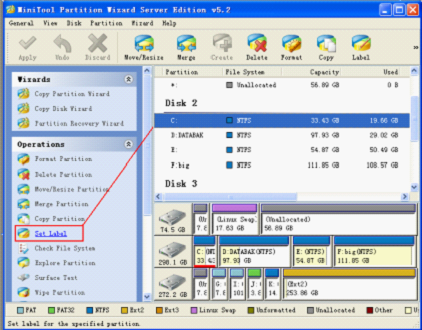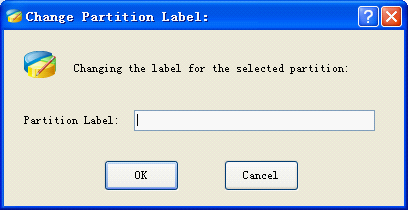Data Recovery -> Volume (Label)
Storage devices
Types of HDD
Partition Series
Linux
Operating Systems
Windows
Volume (Label)
Label is the only sign of disk, generated by format automatically or set artificially. It is only a sign for distinguishing disks.
DOS command can indicate volume (VOL)
1. Function: look up disk volume Label.
2. Mode: internal command
3. Format: VOL[disk letter:]
4. Direction for use: omitted the letter, and indicate the present disk volume. DIR can also indicate the volume.
The common meaning of volume
Under default mode disk partitions are called local disk (C:), local Disk (D:) and so on and they have no volume label. If users rename them, for example System (C:), Game (D:), the volume label of C is System and the volume label of D is Game. Their volumes are the name users given by users.
Volume Label Operation
Disk volume label is a partition table and different operating systems have different partition tables. DOS partition table is standard for applying Linux and Windows. AlphaBIOS and all Linux kernels can read DOS partition. But SRM can not read DOS partition table because boot sector of SMR console is overlapping with DOS partition table in disk. The volume label of BSD is used by several Linux variants including Tru64.Boot block of SRM and volume label of BSD have no conflicts (actually, volume label of BSD is totally stored in the "reserved area" of the first sector), then Linux can use volume label of BSD as well. Users only need to add support for volume label of BSD when compiling the kernel. Volume label of BSD is necessary if users start from disk of SRM. If the disk is not the boot disk, volume label of BSD is not needed. The volume label can be built by FDISK, a standard partition tool in Linux.
Partitioning Method
Disk volume label in DOS is a convenient way
The simplest way for disk partition is to apply installation program of Linux, for example, disk druid or fdisk under Red Hat. Under Red Hat 6.1, an available volume label of BSD is built under the condition that the disk has contained a BSD volume label before. In most instances, a disk volume of DOS will be created. It is readable under Linux but can not be started through SRM. So users may manually create a BSD volume label to start Linux.
Internal Name of Disk
When the user applies a new disk, a label can be pasted on the disk to identify the content of disk. Or it can be given an internal name (volume label). The volume label can be composed of 1to 11 characters. The user can name it or skip. But if the command Format under MS-DOS is applied to format disk, the system will not remind the user to input the original volume label unless the format process is finished. But users can skip it by pressing Enter, which means volume label is not needed. And the user can check the volume label by suing "VOL" command under DOS. For example, the command for checking volume label is "vol c:", and do not forget to press "Enter". In addition, some disk tools such as MiniTool Partition Wizard is not bad.
Click DISK C, and chose"Set label",

What users can change is volume label. If Disk C is shown as Local Disk C:,it means that there is no volume label

The newest edition of MiniTool Partition Wizard can be downloaded in MiniTool Partition Wizard Download Center.
DOS command can indicate volume (VOL)
1. Function: look up disk volume Label.
2. Mode: internal command
3. Format: VOL[disk letter:]
4. Direction for use: omitted the letter, and indicate the present disk volume. DIR can also indicate the volume.
The common meaning of volume
Under default mode disk partitions are called local disk (C:), local Disk (D:) and so on and they have no volume label. If users rename them, for example System (C:), Game (D:), the volume label of C is System and the volume label of D is Game. Their volumes are the name users given by users.
Volume Label Operation
Disk volume label is a partition table and different operating systems have different partition tables. DOS partition table is standard for applying Linux and Windows. AlphaBIOS and all Linux kernels can read DOS partition. But SRM can not read DOS partition table because boot sector of SMR console is overlapping with DOS partition table in disk. The volume label of BSD is used by several Linux variants including Tru64.Boot block of SRM and volume label of BSD have no conflicts (actually, volume label of BSD is totally stored in the "reserved area" of the first sector), then Linux can use volume label of BSD as well. Users only need to add support for volume label of BSD when compiling the kernel. Volume label of BSD is necessary if users start from disk of SRM. If the disk is not the boot disk, volume label of BSD is not needed. The volume label can be built by FDISK, a standard partition tool in Linux.
Partitioning Method
Disk volume label in DOS is a convenient way
The simplest way for disk partition is to apply installation program of Linux, for example, disk druid or fdisk under Red Hat. Under Red Hat 6.1, an available volume label of BSD is built under the condition that the disk has contained a BSD volume label before. In most instances, a disk volume of DOS will be created. It is readable under Linux but can not be started through SRM. So users may manually create a BSD volume label to start Linux.
Internal Name of Disk
When the user applies a new disk, a label can be pasted on the disk to identify the content of disk. Or it can be given an internal name (volume label). The volume label can be composed of 1to 11 characters. The user can name it or skip. But if the command Format under MS-DOS is applied to format disk, the system will not remind the user to input the original volume label unless the format process is finished. But users can skip it by pressing Enter, which means volume label is not needed. And the user can check the volume label by suing "VOL" command under DOS. For example, the command for checking volume label is "vol c:", and do not forget to press "Enter". In addition, some disk tools such as MiniTool Partition Wizard is not bad.
Click DISK C, and chose"Set label",

What users can change is volume label. If Disk C is shown as Local Disk C:,it means that there is no volume label

The newest edition of MiniTool Partition Wizard can be downloaded in MiniTool Partition Wizard Download Center.